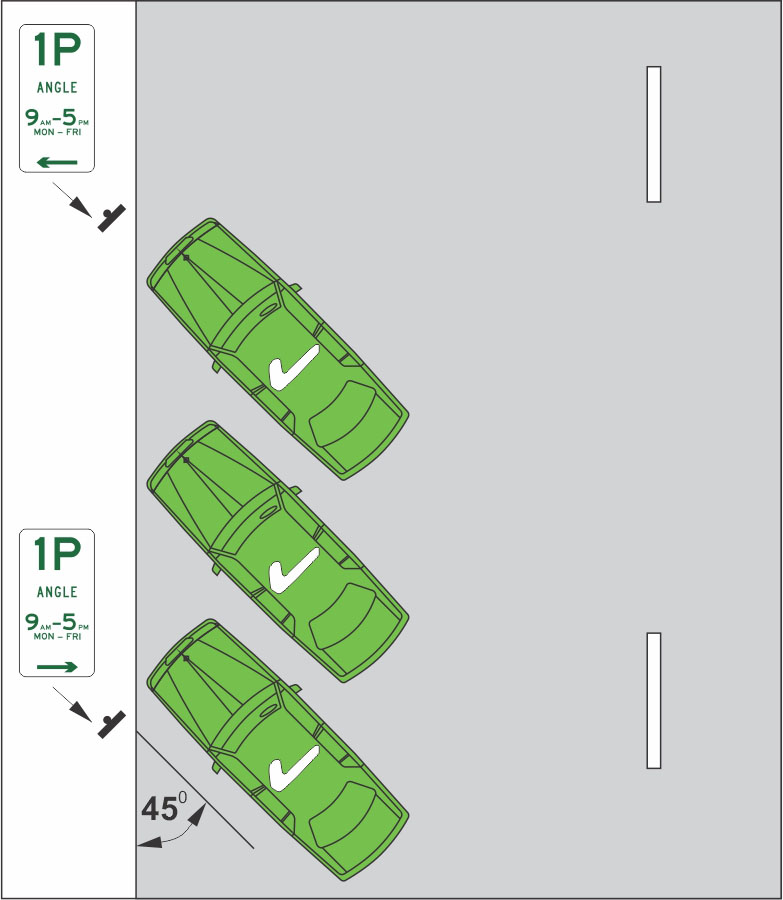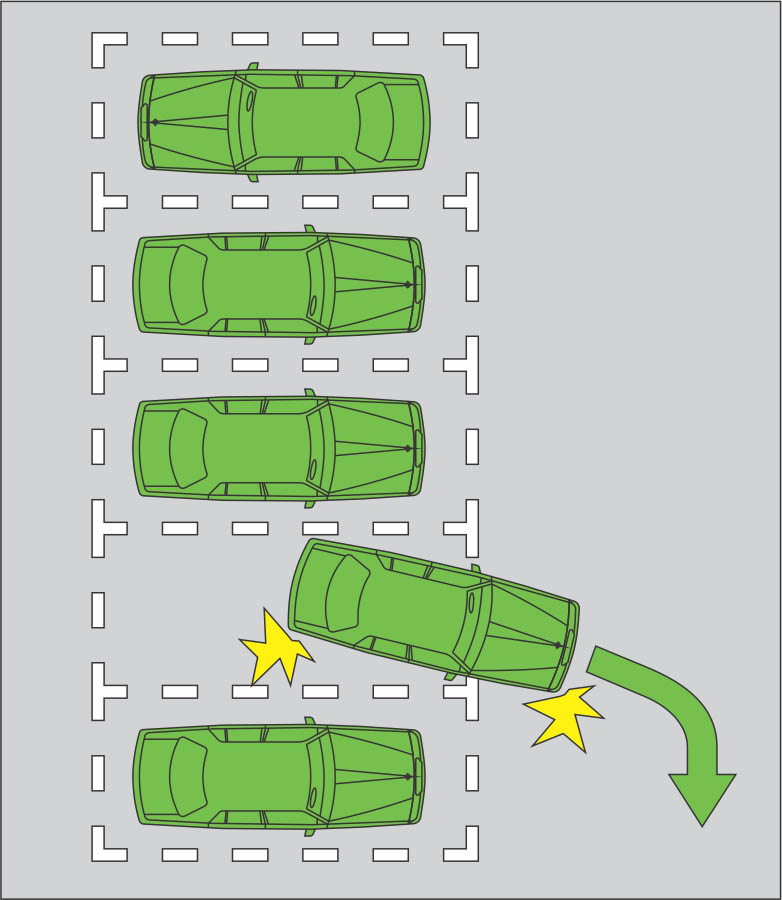Parking rules and fines
Parking rules exist to ensure Queensland roads and streets stay organised and safe for all road users and pedestrians. Parking signs show you where and when you can park or stop. If you do not follow the rules and the signs, you may get a fine.
How to park
You must obey an official sign or line marking telling you how to park. You must not stop at the side of a road marked with a continuous yellow edge line or on a length of road or in an area to which a no stopping sign applies.
If there is no sign or line marking, park so that the left side of your vehicle is parallel to and as close to the left side of the road as you safely can. If you are in a one-way street (not a divided road), you may park parallel to and as close to the left or right side of the road as you safely can.
This is called parallel parking. You must park facing the same direction as traffic in the adjacent lane or line of traffic. You must not park closer than 1m to any other vehicle in front or behind your vehicle when you parallel park. You must also leave at least 3m between your vehicle and a continuous dividing line in the road or the opposite side of the road. Further, you must not stop where you will obstruct the path of other vehicles or pedestrians.
Where parking spaces are marked on the road, you must not take up more than a single space, unless your vehicle is longer than the length of space.
You are not allowed to park on a footpath, painted island, traffic island, bicycle path, shared path, dividing strip or a nature strip adjacent to a road in a built-up area unless a sign permits it.
Angle or centre parking
You may only angle or centre park where there is an official traffic sign permitting it. Park at the angle shown by the road markings for the parking space. Park in the direction stated on the parking sign.


When moving out of a centre parking area, you must enter and leave the parking area by driving forward unless a traffic sign indicates different.


Leaving your vehicle
You must not get off, or out of a moving motor vehicle. Before you open your car door, you must check that there is no one on the road, such as a bike rider, close enough to hit your door.
Secure your vehicle before you leave it unattended.
Parking fines
Parking fines are issued by the Queensland Police Service and authorised officers from local councils using a traffic infringement penalty notice. The notice will tell you what the fine amount is.
If a local council administers parking in its area, a different fine amount may apply.
Parking fine enforcement
The Queensland Police Service is responsible for enforcing Queensland’s parking rules. Also, some local councils are responsible for enforcing Queensland’s parking rules in their area and regulate fine amounts.
Look up and contact your local council to find out their parking fine fees.
Parking fines
Parking and stopping rules apply at all times unless the signed area lets you know different.
You may receive a fine if you park or stop:
- along the length of the road indicated by a no stopping sign
- where there is a no parking sign unless:
- you are dropping off, or picking up, passengers
- you are delivering or collecting goods
- you do not leave the vehicle unattended
In these instances you can stop for a maximum time of 2 minutes unless the sign states different. If you are dropping off or picking up passengers with a disability, the maximum stopping time is 5 minutes.
- where there is a continuous yellow line painted along the edge of the road
- within 20m of any intersecting road where there are traffic lights at the intersection
- within 10m of any intersection without traffic lights unless:
- there are road signs that tell you that you can
- or it is a T-intersection and you are parking along the continuous side of the continuing road
- on a children’s crossing or within 20m before, or 10m after, a children’s crossing (unless there are signs telling you different)
- within 20m before, or 10m after, a pedestrian crossing (unless there are signs telling you different)
- within 10m before the traffic lights of a marked foot crossing that is not at an intersection—or 3m after the crossing (unless there are signs telling you different)
- on a bicycle crossing or within 10m before bicycle crossing—or within 3m after the bicycle crossing (unless there are signs telling you different)
- on a level crossing—or on the road 20m before, or 20m after the tracks (unless there are signs telling you different)
- on a clearway unless:
- you are a bus, taxi or limousine and are dropping off, or picking up, passengers
- there are clearway signs showing days and times on the sign telling you different
- on a freeway—unless you are stopping in the emergency stopping lane because it is necessary for your safety (you must not stay parked in the emergency stopping lane any longer than you have to)
- in an emergency stopping lane—unless you are stopping for your safety or your passenger’s safety
- in a loading zone unless you:
- are a bus dropping off, or picking up, passengers—stopping no longer than 30 minutes
- are a truck dropping off, or picking up, passengers or goods—stopping no longer than 30 minutes
- have a commercial vehicle identification label issued by the local government for that area (stopping no longer than 30 minutes)
- are dropping off or picking up passengers (stopping no more than 2 minutes)
- are dropping off or picking up passengers with a disability (stopping no more than 5 minutes)
- are dropping off or picking up goods (stopping no more than 20 minutes)
- in a truck zone unless you are driving a truck and are dropping off, or picking up, passengers or goods
- in a works zone—unless you are driving a vehicle used in construction works
- in a taxi zone—unless you are driving a taxi
- in a bus zone—unless you are driving a bus
- in a permit zone—unless you have a permit to do so
- in mail zone—unless you are driving a postal service vehicle
- in a bus lane, transit lane, or truck lane unless you are:
- driving a bus, taxi or limousine
- dropping off, or picking up passengers
- in a bus only lane unless you are driving a bus and dropping off or picking up passengers
- in a tram lane, tramway or on tram tracks unless you a driving a tram or a tram recovery vehicle
- in a shared zone unless:
- there are parking bays to park in and you’re allowed to park there
- you are dropping off, or picking up, passengers or goods
- you collect waste or garbage
- between the centre of the road and another vehicle already parked on the side of the road (or between the far side of the road and another vehicle already parked on the side of the road, if it is a 1-way road or street). Known as double parking
- in a safety zone or within 10m before and after the zone (unless there are signs telling you different)
- on a road near an obstruction on the road in a position that obstructs traffic
- on a bridge, ramp or causeway unless:
- the road is at least as wide on the bridge, ramp or causeway as the road is on the lead up to and exit from it
- there are signs telling you different
- in a tunnel or underpass unless:
- the road is at least as wide in the tunnel or underpass as the road on either end of it
- there are signs telling you different
- on or near a crest or curve of road that is not in a built-up area unless:
- you can be seen by other drivers approaching your vehicle from 100m away
- there are signs telling you different
- within 1m of a fire hydrant (an upright pipe with a spout, nozzle or other outlet for drawing water from a main or service pipe in case of fire or other emergency) or fire plug indicator unless:
- you are driving a bus and stopped at a bus stop or bus zone, and do not leave the bus unattended
- you are driving a taxi and stopped in a taxi zone and do not leave the taxi unattended
- within 20m before or 10m after a bus stop unless signs tell you different
- within 20m before a sign that indicates a tram stop, unless there is a sign telling you different
- on a bicycle path, footpath, shared path, dividing strip, nature strip, or painted island, unless signs tell you otherwise
- on a road in a way that blocks access to a footpath or driveway unless:
- you drive a bus and are dropping off or picking up passengers
- you are dropping off or picking up passengers within 2 minutes of stopping
- you park in a parking bay
- you do not leave the vehicle unattended
- on or across a driveway or other way of access for vehicles travelling to or from adjacent land unless:
- you are dropping off or picking up passengers and you drive on within 2 minutes after stopping
- you stop in a permitted parking bay
- on a road within 3m of a post box unless:
- you are dropping off, or picking up, passengers or mail
- there are signs telling you different
- a heavy vehicle or long vehicle (7.5m or longer) along a length of road, outside a built-up area, unless it is the shoulder of the road. In a built-up area, the driver of a heavy or long vehicle must not stop along a length of road for more than 1 hour unless:
- permitted to stop as indicated by a sign
- to drop off or pick up goods
- local laws specify different
- on a road where a bicycle parking sign applies unless:
- you ride a bicycle or personal mobility device
- you are dropping off, or picking up, passengers
- on a road where a motorcycle parking sign applies unless:
- you ride a motorcycle
- you are dropping off, or picking up, passengers
- in a parking area for people with disabilities (where there is a wheelchair sign or marking) unless you display a current parking permit for people with disabilities and you comply with the conditions of use
- in a slip lane unless signs let you know different
- in a parking area for the charging of electric powered vehicles unless your electric-powered vehicle is plugged into or has just been unplugged from an external source of electricity
- on a safety ramp or arrester bed, unless necessary for safety.
The sign may show a different length of time.


